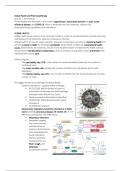Summary
Summary - Global Health, Pharmacotherapy and Communication (WBFA034-05)
- Course
- Institution
Summary of the Global Health and Pharmacotherapy courses with supporting images and tables. The notes from the lectures have been incorporated here.
[Show more]



